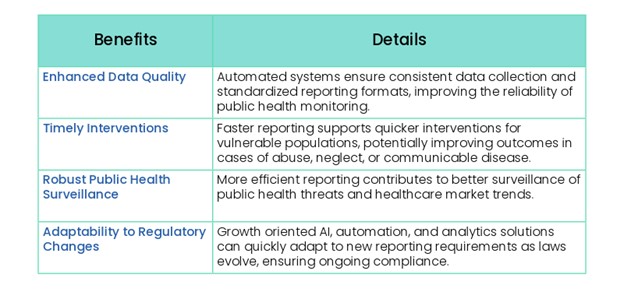The healthcare industry faces an ever-expanding web of mandatory reporting requirements that ensure patient safety and regulatory compliance. From communicable disease notifications to suspected abuse documentation, these reports protect vulnerable populations but often create a significant administrative burden. This article explores how automating mandated reporting through AI, automation, and analytics is modernizing healthcare compliance while allowing clinical staff to focus on patient care.
Mandated Medical Reporting Requirements
Mandated medical reporting encompasses various legal obligations for healthcare providers to document and submit specific information to regulatory authorities. These requirements fall into several categories:
Child abuse and neglect reporting: Healthcare professionals are legally obligated to report suspected cases of mistreatment. These laws vary by state but universally aim to protect vulnerable children.
Public health threat documentation: Requirements for reporting communicable diseases and other threats to public health authorities help monitor and contain potential outbreaks.
Health plan coverage reporting: The Affordable Care Act and IRS mandates require reporting health insurance coverage to employees and government agencies.
Healthcare transaction reporting: State-level laws requiring disclosure of acquisitions, ownership changes, and financial information for oversight and transparency.
Medicare and Medicaid reporting: Several states require providers to report Medicare and Medicaid recipients’ health risk factors to enable the provision of proactive health services.
The complexity and variation in these requirements create challenges for healthcare organizations. Manual reporting processes are time-consuming, error-prone, and divert valuable clinical resources away from patient care.
What are the Hidden Costs of Manual Reporting Processes?
Manual reporting processes create several inefficiencies that impact both healthcare organizations and patients:
Administrative Burden: It is universally recognized that healthcare professionals spend excessive time on documentation. This administrative workload is a major contributor to burnout and job dissatisfaction.
Error Risk: Manual data entry and form completion introduce opportunities for mistakes, potentially resulting in incomplete reporting, missed deadlines, or inaccurate information.
Compliance Concerns: The complexity of varying state and federal requirements makes it difficult to ensure complete compliance, exposing organizations to potential penalties and regulatory scrutiny.
Timeliness Issues: Delays in reporting can impact patient safety, especially in cases of communicable diseases or suspected abuse, where timely responses are crucial.
How AI and Automation Transform Mandated Reporting
AI and automation technologies offer powerful solutions to streamline mandated reporting processes. Here’s how these technologies work in practice:
Automated Data Extraction and Processing
AI-driven tools can automatically extract relevant information from electronic health records (EHRs) and administrative systems. Natural language processing capabilities allow these systems to analyze both structured (test results, billing codes) and unstructured data (clinical notes, medical images), identifying patterns that indicate reportable events.
For example, AI algorithms can scan clinical notes to flag potential cases of abuse or neglect based on specific terminology, injury patterns, or inconsistencies in reported information. Similarly, laboratory systems can automatically trigger infectious disease reporting when certain test results are detected.
Real-Time Alerts and Monitoring
Automation enables real-time monitoring and alerts for reportable events. Rather than relying on busy clinicians to remember reporting requirements, systems can provide immediate notifications when documentation suggests a reportable condition.
These alerts can be integrated directly into clinical workflows, ensuring that healthcare providers are prompted to take appropriate action at the point of care. This integration significantly reduces the risk of missed reporting obligations.
Validation and Compliance Checks
Automated systems include built-in validation checks to ensure data completeness and accuracy before submission. These checks can identify missing information, inconsistencies, or potential errors, allowing for correction before reports are finalized.
Centralized dashboards provide compliance officers with visibility into reporting status across multiple domains, making it easier to monitor deadlines and ensure timely submission.
Streamlined Submission Processes
Once data is collected and validated, automation streamlines the submission process itself. Reports can be automatically generated in the required format and electronically delivered to the appropriate authorities or entered directly into an online portal, eliminating further manual steps.
Real-World Success: Perinatal Risk Assessment Automation
A compelling example of automating mandated reporting comes from a Naviant customer that implemented automation for state-mandated Perinatal Risk Assessment (PRA) reporting.
The Challenge
The organization faced a significant administrative burden with its PRA process. The OB/GYN nursing staff was required to complete these forms each trimester for 1,600 patients annually. Each form contained over 350 fields across seven different sections, including:
- Patient information
- Medical information
- Pregnancy risk factors
- Medical conditions
- Psychosocial risk factors
- Behavioral health screening
- Referrals
This documentation process alone consumed approximately 3,000 hours of clinical staff time annually—time that could have been spent on direct patient care. The complexity of navigating disparate reporting systems, managing exceptions, and correcting documentation errors further aggravated staff frustration and workflow inefficiencies.
What Does a Mandated Reporting Solution Look Like?
The organization partnered with Naviant to implement an automated workflow that transformed their PRA reporting process:
- Automated Scheduling Monitoring: The system identifies appointment types requiring PRA submissions and automatically triggers the information collection process after appointments.
- Data Collection: The system automatically collects required data from the patient’s electronic health record. If information is missing, the system pauses and sends an email to the assigned personnel.
- Smart Form Completion: Once all data is available, the system automatically completes all 350 fields across the seven sections of the PRA form.
- Exception Handling: The automation includes protocols for managing exceptions and missing information. Staff were alerted of the issue via email, and the automated system would rescan the records the next day to check for completion before proceeding with submission to the online portal.
The Results
The implementation of perinatal risk assessment automation delivered remarkable results:
- Time Savings: The 3,000 hours previously spent on documentation were redirected to patient care.
- Improved Accuracy: Automated data collection reduced errors and ensured consistent reporting.
- Enhanced Compliance: The organization achieved better adherence to state reporting requirements.
- Reduced Staff Frustration: Clinical staff reported higher job satisfaction when freed from repetitive documentation tasks.
- Better Patient Care: More time for direct patient interaction improved the quality of prenatal care.
Benefits Beyond Time Savings
Healthcare automation solutions for mandated reporting deliver benefits that extend far beyond simple time savings:
Implementation Considerations for Healthcare Leaders
For healthcare organizations considering automating mandated reporting, several key factors should guide implementation:
- Start with High-Volume Reports: Begin automation efforts with high-volume, standardized reports that create the most significant administrative burden.
- Ensure Stakeholder Involvement: Include representatives from clinical, IT, compliance, and administrative departments in planning and implementation.
- Focus on Integration: Ensure seamless integration with existing EHR systems and clinical workflows to minimize disruption.
- Implement Robust Validation: Verify automated reports against manual processes during initial implementation to ensure accuracy and completeness.
- Provide Comprehensive Training: Ensure all staff understand how the automated system works and their role in the reporting process.
The Future of Automating Mandated Healthcare Reporting
The evolution of AI, automation, and analytics in healthcare reporting continues to accelerate. Future developments include:
- Predictive analytics to identify potential reportable events before they occur
- Enhanced natural language processing for more accurate data extraction from clinical notes
- Expanded interoperability between healthcare systems for coordinated reporting
- AI-assisted decision support for complex reporting requirements
Automating mandated reporting represents an opportunity for healthcare organizations to improve compliance, reduce administrative burden, and enhance data quality. By implementing AI and automation solutions for reporting requirements, healthcare leaders can redirect their valuable clinical time.
As regulatory requirements continue to develop, investing in healthcare automation can yield significant returns through improved operational efficiency and better patient outcomes. The time to explore these solutions is now. Your organization’s efficiency, compliance, and staff satisfaction may depend on it.
For More Information:
Learn more about mandated reporting requirements at the National Institutes of Health Resource or explore state-specific requirements through resources like Maryland’s Department of Human Services.






